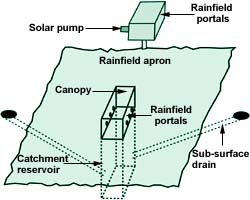|
Solamar International Incorporation is based in Arizona state in USA. They are involved in devising methods to provide clean and healthy drinking water. The Solamar EmerexIs a portable system, embodying convenient and easily workable methods for water purification towards safe drinking water. Apart from cities and rural areas, the system is designed to store, treat and dispense drinking water in special situations like epidemics, disasters and refugee sites, in the absence of a well
established supply of clean drinking water. The system consists, of a container and a mixer. The container, with capacity ranging from 10 - 2000 litres, can be made from plastic, cement, wood or any other locally available material. The size of the water container may be modified to suit a variety of user conditions from personal to community use. The mixer is an inexpensive plastic hand-operated stirrer designed to introduce disinfectants, special medications or supplements in the water. A spigot may withdraw the treated water otherwise siphoned or dipped out. Solamar strongly recommends the incorporation of trained personnel in the storage, purification and distribution system, for proclaiming safe and practical directives in promoting potable water and public health issues. The Solamar Watershed NetworkIs based on the simple concept of collection and storage of rainwater for dry periods, when the need for water is critical. It is designed to provide water for agricultural, livestock and human requirements. The system consists of a central collector and a surrounding catchment that feeds into it. The collector is simply a trench, ditch or a channel dug in the ground. The surfaces of the collector are lined with a waterproof liner sheeting to protect the integrity of the excavation. The size of the trench may range from a modest 2 cubic metres (1m x 1m x 2m) to a large volume of 10,800 cubic metres (3m x 9m x 400m). The collector can be incorporated into existing landscapes by designing suitable patterns, size and location of the "water holes" (collector). Rainfield apron is the treated catchment area of the collector, which feeds rainfall runoff to the collector. The catchment may be treated by laying out or spraying a non-porous surface on the natural base. Water running from the rainfield apron into the collector is filtered with a screened inlet. Additionally, a secondary network of drains outside the apron can feed the rain to the collector through sub-surface irrigation pipes. Before usage, the water is to be treated, with the level of treatment being determined by its expected usage. While water for agriculture and livestock needs little or no treatment, water for human consumption requires a greater degree of disinfection. This system may be incorporated into existing storm water disposal systems in cities or rural areas by directing storm water runoff channels to a central reservoir. |

